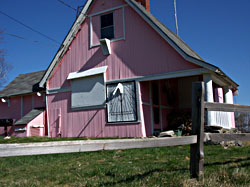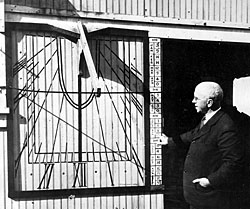

The Porter Clubhouse Sundial:
Counting the Daylight Hours
by Jay Drew, Springfield Telescope Makers [2006-Oct-1]

The Porter Sundial at Stellafane in Springfield, VT
Russell W. Porter was truly a renaissance man. The artist, scientist, and polar explorer designed the clubhouse of the Springfield Telescope Makers with a number of intriguing features. Like an imaginative tree house, Stellafane is stuffed with whimsical playthings. There are several telescopes built in to the walls, windows, and ceilings. Outside, the sundial on the historic clubhouse is another example of Porter's creativity.
Description
Built in 1927, the Stellafane Sundial is a South Vertical type. It is made of painted wood and placed perpendicular to the horizon on the back wall of the Stellafane Clubhouse, facing due south. The gnomon is also wooden with the style pointing to the celestial pole. The style height is set at 47 degrees (to compliment Stellafane's latitude of 43 degrees North). Since the the gnomon is only 5 feet above the ground it is protected from unexpected damage by a copper wire extending from east to west across the dial.

Overall, the sundial measures 52.5" wide and 55" tall. The 12 o'clock line lies in the plane of the meridian and the hour lines measure time from 6am to 6pm. As with all south vertical sundials, the sun will not shine on the face before 6am or after 6pm. The dial is painted black and white, contrasting nicely against the traditional pink of the clubhouse.
Furniture on the dial plate includes the hour lines, Russell Porter's signature in the bottom right corner (reading "RWP July 1927"), and a table of corrections used to obtain mean solar time using the Equation of Time. Interestingly, the table does not seem to include the corrections for longitude shift; Stellafane, at 72° 31' West longitude, is offset from the Eastern Time Zone meridian (at 75° West longitude) by three and half degrees, or about 10 minutes, which should be added to the sundial reading. Summing the corrections for the Equation of Time from the table and the 10 minutes of longitude adjustment should yield Eastern Standard Time.
Visiting the Stellafane Sundial
Stellafane is open to the public during the annual Stellafane Convention. Information on attending can be found on the convention webpage. Special arrangements for North American Sundial Society members (and other interested sundial lovers) to visit at other times of the year may be made by emailing STM Member Jay Drew.
Back to the Early History Page